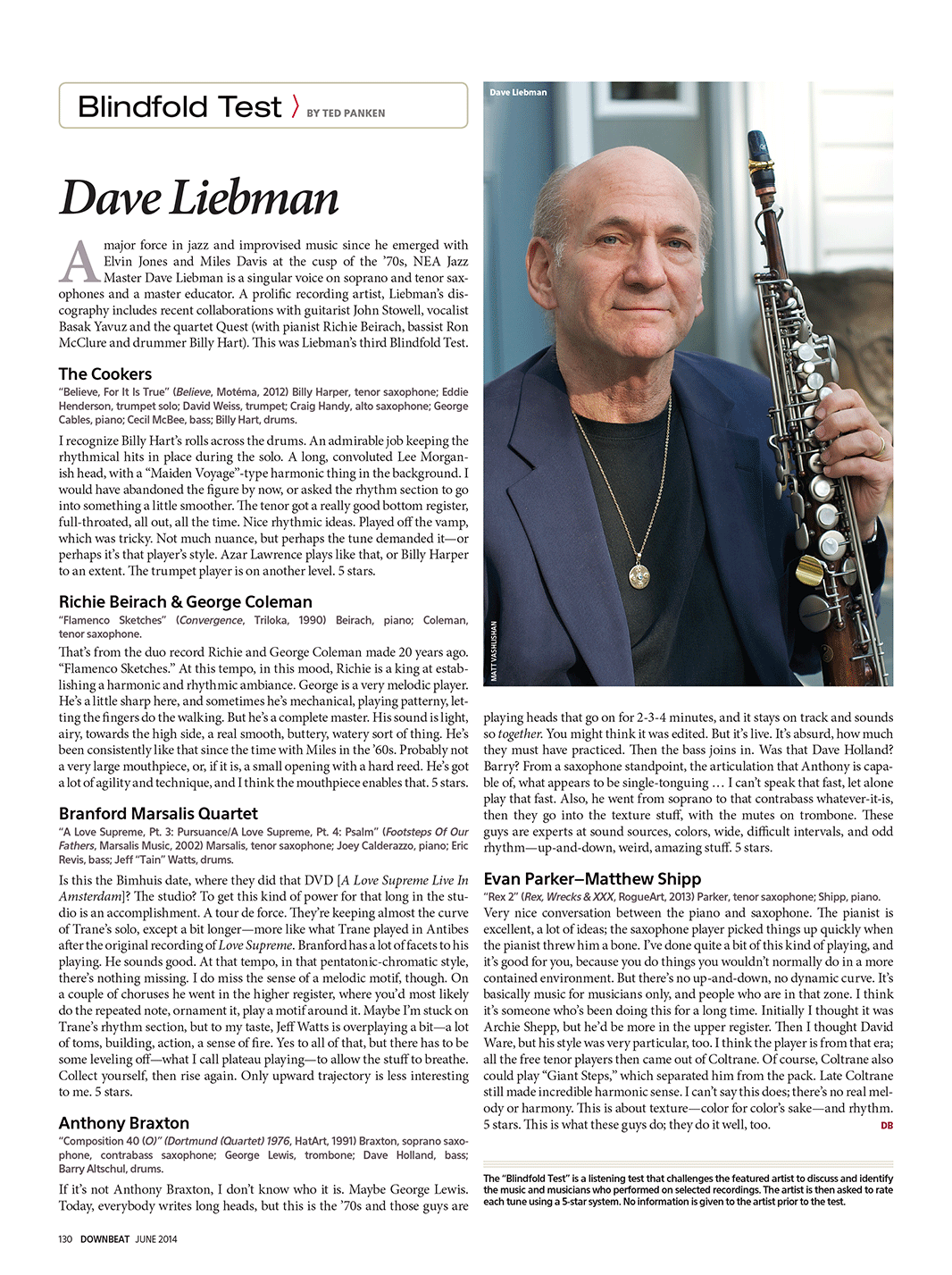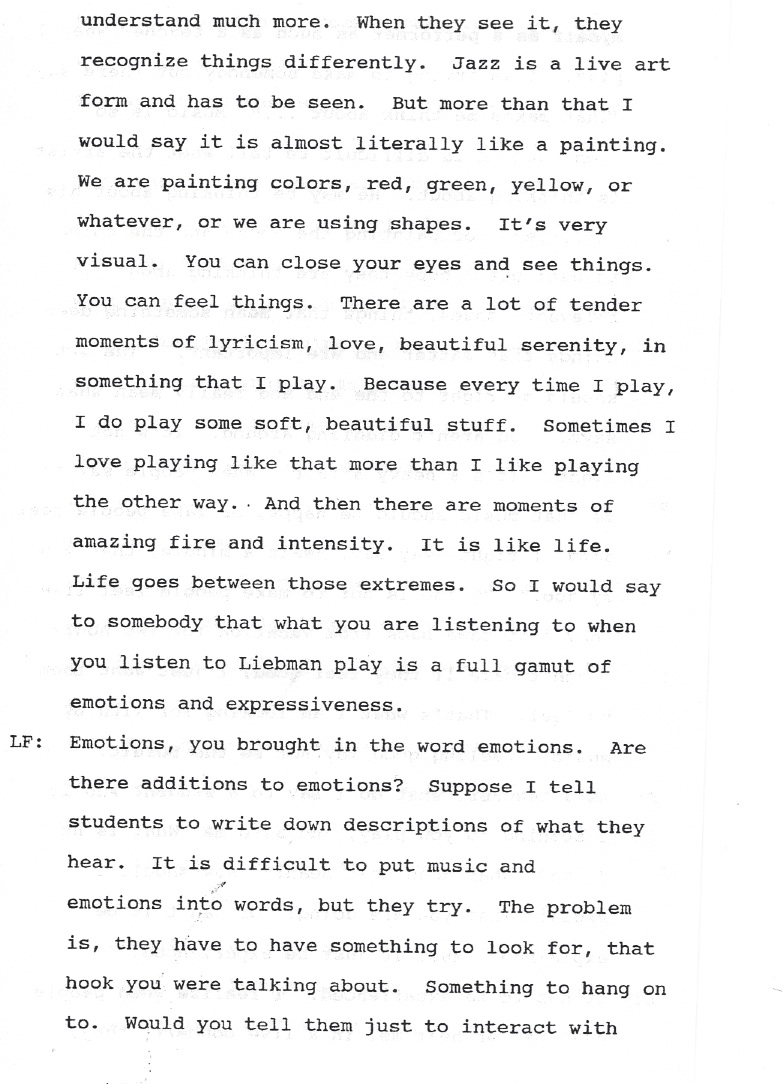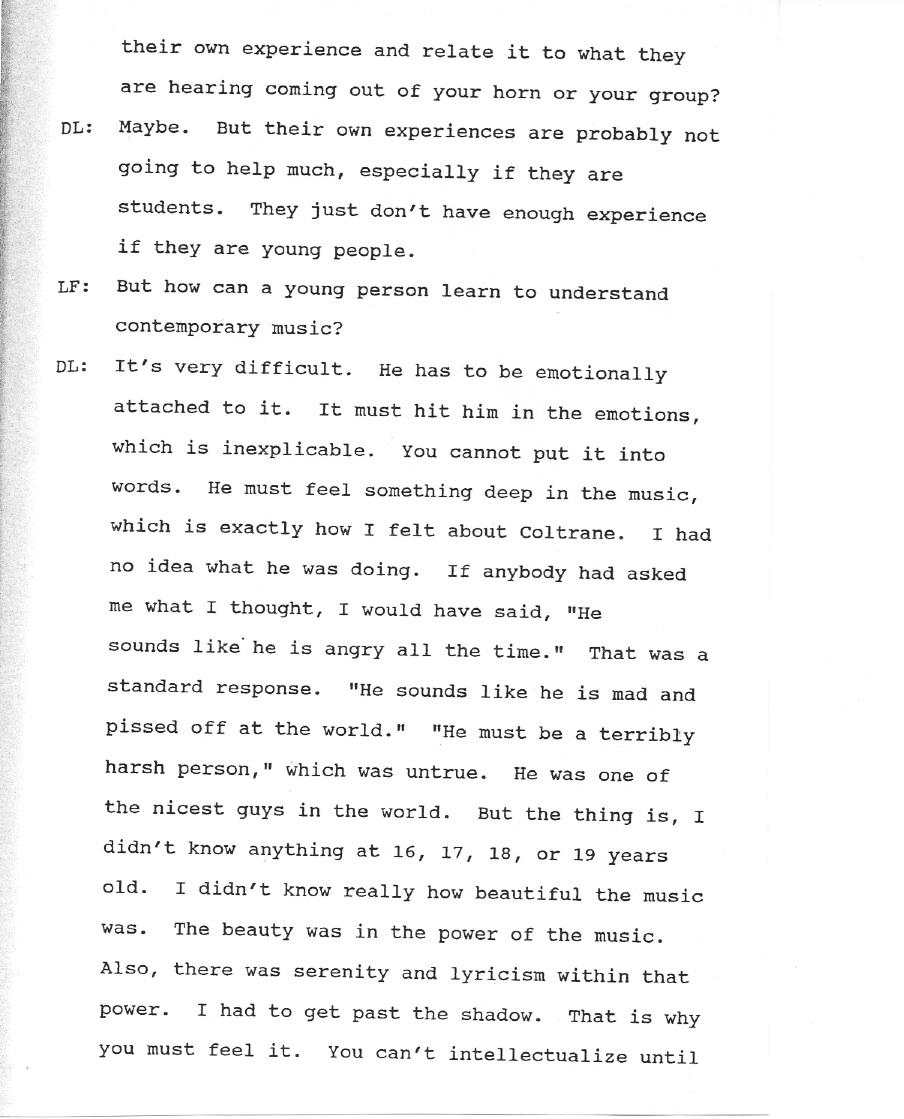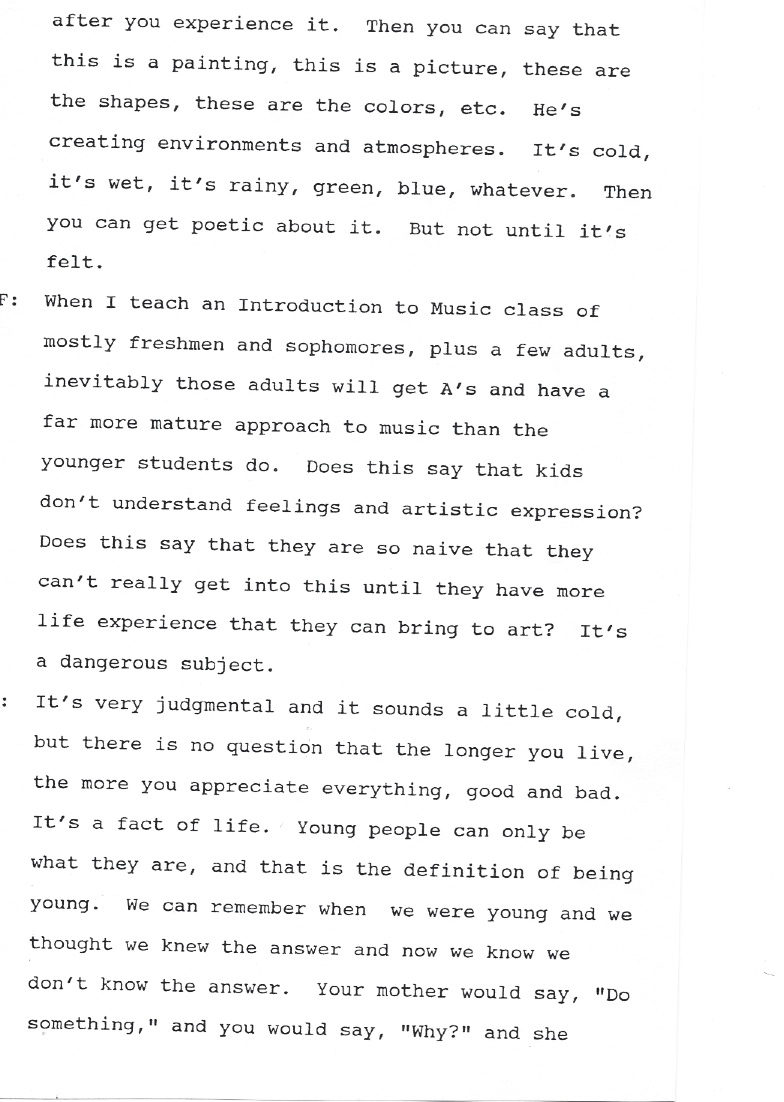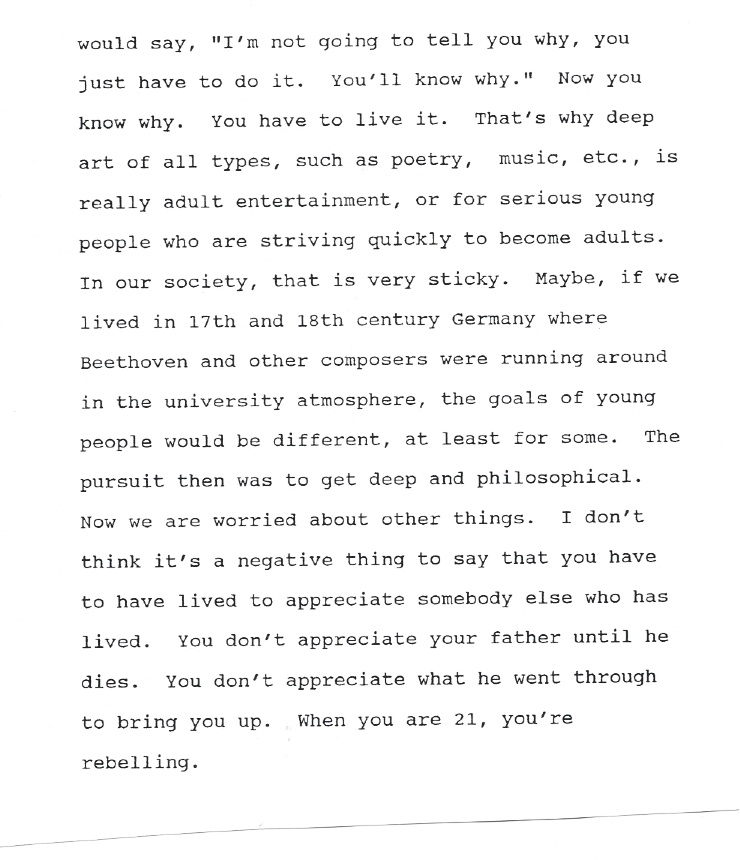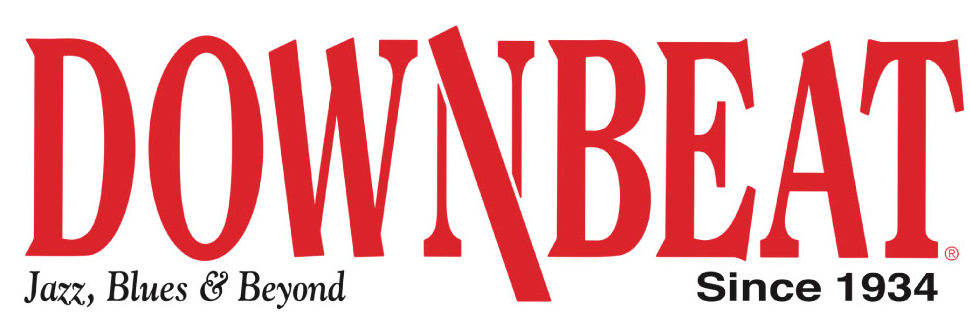In the 1990s, David Liebman surveyed 256 young student/musicians. A total of 37 (14%) participants attended his annual International Saxophone Master Class at East Stroudsburg University of Pennsylvania (ESU) between 1994 and 1997; and 219 (86%) attended the annual meeting of the International Association of Schools of Jazz (IASJ).
Both of these yearly events presented an opportunity to survey a select population on matters ranging from the personal to the philosophical. The goal of the survey was multi-faceted: to collect some basic information about the backgrounds, listening habits, and other influences that have informed these students’ musical lives as well as cause them to reflect upon matters that form one’s world view, which is an intrinsic component of being an artist.
We hope that this survey will inspire more research into who is being taught jazz worldwide-and their hopes and aspirations for the future.
Respondents’ Profile
Country
Respondents to the survey came from 5 continents and 28 countries: the United States, Germany, England, Austria, Sweden, Spain, France, Italy, Netherlands, Switzerland, Denmark, Finland, Israel, Japan, Ireland, Brazil, Canada, Norway, Australia, Portugal, Estonia, Hungary, Mexico, New Zealand, Poland, Scotland, Slovenia, and Uruguay. Most participants came from Europe, but the United States was also heavily represented. Asia, Australia, and South America had few representatives, which was to be expected given that all surveys were taken in Europe or the United States.
Gender and Age
There were 13% female respondents and 87% males. A total of 90% gave their age on the surveys, ranging from 14 to 67, with the majority being in their twenties. Of those in their twenties, the data were skewed slightly toward those in their early twenties, which is to be expected since most have undergraduate or graduate music school affiliations.
School Affiliations
Some type of school affiliation was indicated by 95% of the respondents. The remaining 5%, who were part of the Liebman Master Class held at ESU, indicated other reasons for attending, such as being a freelance performer or amateur/novice performer. 83% were students, 10% teachers, and 2% administrators. Schools with the significant representation of 5 or more participants included The New School (New York, NY); Royal Academy of Music (London); Royal Conservatory (The Hague); Berklee College of Music (Boston, MA); Skurup Folkhogskola (Skurup, Sweden); Bruckner Konservatorium (Linz, Austria) ; Conservatory of Montreux (Montreux, Switzerland); Musikhochschule Graz (Graz, Austria); Rimon School of Jazz (Tel Aviv, Israel); Siena Jazz Association (Siena, Italy); Taller de Musicos (Barcelona, Spain); Hans Eisler Music School (Berlin); Musikhochschule (Koln, Germany); Sibelius Academy (Helsinki, Finland); Taller de Musicos (Madrid, Spain); Fridhems Folkhogskola (Lund, Sweden); Koyo Conservatory (Kobe, Japan); Newpark School Centre (Dublin, Ireland); Rhythmic Music Conservatory (Copenhagen, Denmark); Hochschule der Kunste (Berlin, Germany); and Jazz and Rock Schule (Freiburg, Germany).
Performing Media
Since the questionnaire was open-ended, some participants listed as many as 6 performing media. The most-listed medium was saxophone(s), with piano/keyboard as a close second. Other significant media in order included drums/percussion/mallet percussion, flute, string/electric bass, guitar, clarinet(s), and voice.
PART I
In Part I of the survey, Liebman attempted to ascertain what drew students from around the world to jazz and who influenced them: “I thought that it would be of great interest for educators to see how these students entered jazz, what books, records, and other musicians have affected them most in the musical realm.”
Family Musical Background
Participants were surveyed regarding other members in their family who played instruments or sang. Of the 256 participants, 48% indicated that at least one member of their family performed at some level. Some listed as many as four family members who performed. 2% indicated that they had professional musicians in their immediate family.
Piano or church organ was listed as being played by a family member by 17% of the participants. Violin, viola, and cello were listed by 7% of the participants, which strongly suggests they had a classical string (orchestral) influence. 6% of the participants named vocalists as relatives. Guitar was mentioned by 5% of the participants; trumpet and saxophone were each mentioned by 5%; and clarinet and drums/percussion were each mentioned by 2%. Flute or trombone were mentioned by 2% of the respondents.
How did you become interested in jazz?
Several respondents indicated either people and/or media that inspired their interest in jazz. Recordings were mentioned by 35% of the respondents, friends by 13%, a teacher by 10%, parents by 5%, and radio by 5%.
What was the first live jazz performance that made an impression on you? List musician(s) and/or group(s).
The performers mentioned more than three times were Chick Corea (7%); Miles Davis (5%); Pat Metheny (4%); Weather Report, Art Blakey and the Jazz Messengers, Herbie Hancock, Keith Jarrett (3% each); and Dizzy Gillespie, Dexter Gordon, Sonny Rollins, Count Basie, Michael Brecker, Ella Fitzgerald, Wayne Shorter (2% each).
What was your age when you attended the first live jazz performance that made an impression on you?
There were 139 (54%) responses to this question, and the ages cited ranged from 3 to 32 years. The most significant ages were 13 to 18, where 96 (69%) of the 139 respondents fell. 16% identified an age from 19-32, with another 15% from age 3-12.
What recordings, books, and movies have most influenced you?
Recordings were clearly mentioned most often as providing a major influence. Overwhelmingly, the most influential recording was Miles Davis’ Kind of Blue, named by 10% of the respondents; John Coltrane’s A Love Supreme, Keith Jarrett’s Standards Vol. I or Vol. II, Sonny Rollins’ A Night at the Village Vanguard, and John Coltrane’s Crescent each received 3% mention; and Miles Davis’ Milestones, pianist Bill Evans’ Sunday at the Village Vanguard, and John Coltrane’s My Favorite Things each 2%.
Books and movies were also significantly mentioned. Some respondents detailed multiple items. Books were mentioned 55 times, including non-music books. The most-named books were the Miles Davis autobiography (17 times), biographies about John Coltrane (5 times), and Duke Ellington’s autobiography or biographies (5 times). Jazz movies listed were Round Midnight (18 times), Bird (7), and Thelonious Monk: Straight No Chaser (3). Several non-jazz movies received one mention each.
Often participants mentioned an artist in addition to a specific recording, book, or movie. Those artists mentioned most frequently were Miles Davis (35%); John Coltrane (25%); Keith Jarrett or Charlie Parker (12% each); Sonny Rollins or pianist Bill Evans (9% each); Herbie Hancock, Pat Metheny, or Wayne Shorter (5% each); Chick Corea, Weather Report, Dexter Gordon, Duke Ellington, Charles Mingus, or Thelonious Monk (4% each); Ella Fitzgerald, McCoy Tyner, Cannonball Adderley, J.S. Bach, Art Blakey and the Jazz Messengers, Joe Henderson, or Jaco Pastorius (3% each); and Michael Brecker or Joni Mitchell (2% each).
Additionally, recordings, books, or movies related to Miles Davis and John Coltrane were mentioned most often (cited 95 and 78 times, respectively).
PART II
Part II of the study focused on the students’ views on issues. Liebman stated: “I inserted questions that concerned their view of the world. The main goal at first was not so much to gather information but more to prod the students to think about issues raised by the questions-to reflect upon matters not directly related to playing jazz and begin to form a world view as an artist.” Because of the nature of the questions, a majority of the summary that follows is comprised of quotations from the respondents.
What other art forms interest you and why?
239 (93%) of the 256 respondents listed other arts that interest them. While 14 respondents indicated that all of the arts interest them, many other individuals listed interest in as many as five other art forms. Painting was most often mentioned, with cinema/movies/film following. Others mentioned include literature, theater/drama, dance/choreography, sculpture, photography, poetry, and architecture. While most respondents specified specific visual art forms, 4% mentioned “visual arts.” Interestingly, classical music was mentioned by 3% as another art form.
All Art Forms
Finland: Studying artistic values of all forms of art will also deepen the understanding and conception of music as art.
Germany: All arts are interesting because one is being creative with given structures. They have traditions, rules, development, and improvisation. It’s interesting to see the parallels between a given structure and what you can do with it in a creative way.
Ireland: I think it is important to look at what is good in other arts to see what you can bring to your own culture.
Sweden: From all art forms, you can learn a lot about emotions, life, people, nature, and of course, about yourself.
Dance and Theater
France: I enjoy theater because it is a live performance; and as in music, characters and the director can give different meanings to the same sentence.
Uruguay: Dancers make me see music.
Visual Arts
Ireland: It’s nice to focus completely on drawing and painting as a contrast to music because they are so silent.
USA: Architecture is the mathematics and construction of a big work of art. With painting we seek to understand what the artist was trying to convey.
The Written Word
Austria: Literature opens up your mind and makes you look at other points of view and think from other points of view.
Canada: I have always been interested in poetry for its condensation to essentials.
What do you want to do with your music?
The 247 (96%) respondents to this question gave a wide variety of answers as to their future goals in music. Most responses could be categorized as communication (communicate, communicate emotions, affect the world, teach); internal processes (learn, express myself, happy/fun/enjoyment, play/perform); documentation (record, compose); and monetary income (earn money/make a living).
Playing/Performing
USA: I want to play my music for people, preferably in related settings. I would like to create more situations that are a hybrid between a formal concert and a bar…create a world for people to get lost in for a while through music.
Happiness/Fun/Enjoyment
France/Morocco: Music has become my friend and no longer a means to become known.
Communication
Netherlands: Create a moment of fulfillment for the listener and the fellow musicians.
Affecting the world
Finland: First, I’d like to acquire something that I could justifiably call my music and then expand ideas, express myself, and make social and political statements.
Expressing Myself
Italy: I need music to live, and my goal is being able to forget my ego so that the real me comes out through the music I play or sing.
Learning
France: To develop myself in order to be able to have a better understanding of the people in the world.
Teaching
USA: I want my music to be good enough to be used as a teaching device, much like what we do today with our past (musical) jazz heroes. I would like to build a bridge with jazz from the older generation(s) to the younger ones who are missing out on this fun.
Communicating Emotions
Sweden: Communicate, evoke feelings, and also enjoy myself while I’m playing-and at last, develop myself as a human being on this planet.
And finally…
Austria: At the moment I only want to graduate.
What is the relationship between jazz and your culture?
The relationship between jazz and the students’ culture received 181 (71%) detailed responses. The remainder of the population gave no response or indicated they could not answer the question. Several indicated that this was a difficult question or that they did not feel that their English was good enough to respond. Of those who responded, 17% felt that there was no correlation between jazz and their culture. A number of respondents described the correlation between music and culture, but did not discuss jazz specifically. There was some mention of folk music by 7% of the responses.
Austria: There is no jazz tradition in Austria, but there is a scene and an amount of people who are interested in jazz and folkloristic jazz. This culture is influenced by America.
Canada: Canada is in transition and jazz melded with ethnic influences is quite possible.
Denmark/Sweden: There is a lot in common between my Swedish folk music and jazz. They are both rhythmic and use improvisation.
England/Ireland: Irish folk music is almost entirely improvised and involves the participation so vital to its effectiveness (as with jazz). Britain’s interest in jazz is an imitation of America’s art form. Influences from different cultures in Britain are slowly mixing with jazz.
Finland: Because jazz is an American art form, it has a strong international aspect from a Finnish point of view. Fortunately, jazz is quite respected in Europe.
Japan: Jazz is one of the most Westernized art forms brought over to Japan and was very closely related with the dance boom in Japan.
Italy: Jazz is a free language that can unite.
Netherlands: I’m out of a Dutch, Western European culture; so my music will always sound like that.
New Zealand: The jazz that is performed in New Zealand reflects the European and American cultures.
Sweden: My culture is the Western music you know but also some folk music. There have been people in Sweden trying to mix ethnic music with jazz.
Switzerland: In Switzerland, jazz is music for a minority of people. It’s regarded as intellectual stuff-with the exception of Dixieland, which is very popular in my parents’ generation.
USA: The fundamental elements of jazz-rhythm, swing, improvisation-are present in Peruvian music, especially Afro-Peruvian music.
What is the relationship between your music, your culture, and the outside world?
This question received 173 (68%) detailed responses. Of those responding, only 2% felt that there was no relationship between their music, their culture, and the outside world.
Austria/Germany: The more I sang and wrote music, the more I found my culture coming through my music (gypsy music) as well as different styles not related to my heritage.
Brazil: Our Brazilian culture is strong, and world music is heavily influenced with Brazilian rhythms and phrases.
Denmark/Sweden: Living in Scandinavia, I try to find and push my folk music and roots in my music. The sounds and life are different in Copenhagen compared to New York.
France: Let’s flush out the borders! Jazz and improvisation is freedom. I hope my music will become an expression of myself and my culture, and I hope to be able to share it with great spirit with the outside world.
Germany: One world. One music. Mix it! Fix it!
Italy: The world needs our little, positive, but unique contribution. I feel that there is only one god with different names and only one language: music. As human beings we are all equal.
Japan: The movement, the throbbing, and the creativity of music are part of the important aspects of human values.
New Zealand: I hope that just by following my instincts and being myself, I will have something pure to offer the world. Creating something “real,” I believe, is one of the most positive things we can do for the world today.
Sweden: My music is hopefully a reflection of my life and thereby also a reflection of my culture, and of the things going on in the world.
Switzerland: Since I grew up in a culture, it will always be a part of me. After I was able to make my own decisions, the “outside” always attracted me.
USA: My culture does not embrace jazz. I live in a pop culture that caters to the lowest common denominator.
What world issues most draw your attention and why?
This inquiry was answered by 216 respondents (84%). Some mentioned current events such as the fall of communism, Gulf War tensions, and conflicts in the early 1990s. The world issues most concerning those who answered the question were Ecology (environment/nature/pollution, 29%), Peace (21%), Racism (9%), Money/Economy (7%), Politics (5%), Religion (4%), and Lack of Communication or the issue of Hunger (each 3%).
Ecology: environment, nature, pollution
England: The destruction of our natural environment concerns me because the next generation deserves the right to live in a decent world.
USA: Environment: the enormous problems we face are a terrifying sign of our spiritual ambivalence and violent rejection of the original knowledge of native cultures.
Desire for peace/disdain for war
Germany: War: it is scary to see the dark side of human nature.
New Zealand: War: any situation in which people cause each other to suffer astonishes me. Not only do I despise wars, but I cannot understand how they could possibly happen.
Racism
England: Racism: I think there’s still a little bit of segregation in jazz music.
USA: Racism: it amazes me how we can love the music of a culture; we can tan ourselves until we peel; we can inflate our lips, breasts, and butts to look like a certain culture; but when it’s one on one, we can’t accept people for who they are.
Money/economy
Norway: The rich nations holding the poor nations as slaves. The poor earn almost nothing making cheap products.
Spain: Economic differences are getting worse for the third world, which will bring unpredictable consequences in the near future.
Politics
Brazil: Capitalism: when someone wins, someone else has to lose.
England: The world collapse of communism draws my attention because I know that what existed has only been an attempt at communism and not communism itself. I believe that only through true communism will the world be freed from injustice.
Religion
Canada: I am saddened by the role religion plays in so much of today’s strife. I am very concerned about the environment and its degradation-there is nothing if we have no earth! Worship of money and corporate moral bankruptcy are also problems.
Lack of communication
Denmark: The social and economical development in the different regions of the world with its extreme tensions, and the development of modern communication systems like the Internet. Because this will influence my life now and in the future, and I am starting to be afraid of this.
Germany: I am interested in how the media worldwide deals with political events. Can they influence decisions in law courts?
Ireland: Why must there be media hype before any issue is addressed by governments? The fickle nature of such media coverage results in unbalanced handling of global issues (for example, Bosnia).
Switzerland: People are too selfish, and they don’t know how to listen to other people or to themselves.
Hunger
Germany: It is absolutely perverted that people die of hunger in the third world.
USA: I don’t understand how hunger, racism, and crime can exist.
General comments
Finland: What gets put in the food to make it less nutritious, like hormones and preservatives. Also, the inhumane treatment of animals that are raised to be eaten.
Netherlands: The lack of self-knowledge, honesty, and application of simple wisdom. From this stems the more concrete issues such as violence (wars) and hypocrisy on a global level regarding the unequal division of wealth. This also provides the conditions for the existence of moral codes in the political and economic arenas such as we know them now.
Portugal: All issues that show people’s disrespect for themselves and others.
Sweden: The worst thing is that there are too many mean people in the world because of a long tradition of bad education and bad raising of children.
< expressed. also were (5%) doing is one what of understanding and (6%), honestly self one’s expressing (7%), inside from voice own finding (9%), ?trust? or truth>
Austria: It’s a special way to live, with creativity. It’s not only important for your music but also for all aspects in living.
Canada: I have believed for some time that all humans are driven to create. Some do it via creating children, others through house construction, others through the arts, or the like. I believe each person has at least one creative niche and needs to find it. (Denmark) I believe that we need inspiration from all sorts of things, people, places. Also to be able to be really creative so it really will get to people. I guess if you dare to stand behind yourself and what you do, you will grow.
England: Creativity keeps the mind active and is stimulating; originality is achieved through creativity.
Finland: They come of open-mindedness and courage and trust. They occur in everybody, but most of us are taught not to use them. But you really can’t get through to other people without them.
France: They must be developed by practice. It’s hard to balance the search for originality and the necessary repeat and practice of the tradition of jazz.
Germany: What goes in, comes out. The most important thing to a jazz musician is the broad input from all kinds of music and life experience (including pop and classical).
Holland: Creativity is the ability to finish solutions to a problem or task that are not obvious or closely related to your personality. Originality is not wondering whether what you do has been done before.
Norway: I must be creative to be happy with life, and originality is a question of really finding my own person and being honest with other people.
Sweden: These are natural forces; get prepared to be spontaneous as often as possible.
Switzerland: Creativity grows in a situation where a person or group lives in the moment without consciousness. Originality is a result of study, understanding, and transforming in an honest way.
USA: I will never do anything original in music. I can be creative. I’m only trying to be true to myself.
What relationships do you see between jazz and other forms of music (i.e., classical, pop, folk, world)?
This question was answered by 131 (51%) of the respondents. Classical music was mentioned by 24%, pop/rock by 17%, world music or the aspect of rhythm by 8% each, and the aspect of harmony by 4%.
Austria: Jazz is that kind of music where musicians try to combine different experiences which they had in other forms. There is a lot of give and take.
England: As Duke Ellington said, “There are only two forms of music: good and bad.”
Finland: I find all styles mentioned above interesting at some level. Jazz musicians can learn a lot about simplifying and clarifying music.
France: All forms of music influence each other. Can we give music labels? What is jazz and what isn’t?
Japan: It seems to me that European people consider jazz as one art form of modern music (including classical music). However, most Japanese people consider jazz as a totally different music form and it doesn’t have any relation to classical music or rock.
Netherlands: Classical music gave the foundation for jazz harmony that is used. My feeling is that jazz and classical music are closer to each other than ever.
Sweden: Jazz is one of the few music styles where all of these forms of music can meet and be used freely.
Switzerland: Classical music and free improvisation are just other forms of organization.
USA: Classical’s harmony relates to jazz; Pop’s lyrics, phrasing, some harmony, solos do; World Music’s rhythm, phrases, and harmony do.
In what ways can art in general influence individuals, events, and the world?
This topic was answered by 131 (51%) persons. Again, the answers varied widely. Topics such as inspiration, creativity, bringing people together, and spirituality were mentioned about a half-dozen times each.
Austria: I don’t really think that art can change things in the world.
Brazil: Art could be the great world language.
Denmark: It can bring people together: art is universal.
England: It can inspire individuals to do things and also comment on world events.
Finland: Art is able to evoke emotions that aren’t possible to verbalize.
France/Morocco: It’s the best instrument to make people all over the world meet and talk. It’s the best instrument for peace.
Germany/Austria: Art to me is a very important part of the world’s evolution. Music and other arts have always been there, and real art seems always to be ahead of its time.
Holland: Through the education on certain topics of discussion, develop a sense of borrowing and consonance; develop a taste of your own to make life decisions.
Hungary: Arts can change the emotions and thoughts of the individuals if they are able to accept them.
Ireland: Although we need a certain amount of ego to perform at all, I think that truly pursuing art destroys the ego and brings us closer to our spiritual reality.
New Zealand: I think there comes a time in the learning of an art form where in order to improve you have to come to a deeper understanding of the world and its spirituality. I think art has this effect on anyone who allows it to.
Norway: Art is food for the mind: imagination and fantasy.
Sweden: Many times art can predict future events in the human society and even influence people into going in certain directions because it doesn’t have any restrictions. Art can be provocative, innovative, critical, and educational; and it speaks right to the beholder without being judicial.
Switzerland: Since in art there is no past or future (in the moment of producing or consuming), it teaches individuals theory that events can be great.
USA: By pursuing excellence, surviving, and stretching or testing the intellectual and emotional boundaries of the world audience.
In what ways can jazz be used to influence individuals, events, and the world?
There were 114 (45%) responses to this question, with the answers varying widely: topics such as inspiration, creativity, bringing people together, and spirituality were mentioned about a half-dozen times each.
Austria: It can be seen as a universal/global art form and can be used as language/communication.
Canada: Jazz must be relevant to the times and not existing in museums. The harmonious blend of improvisation and rhythm should serve as a model for human cooperation and interaction.
England: The freedom and energy could inspire individuals to do something creative, but jazz is too much of a minority interest to have a wide-scale effect on the world.
Estonia: It’s developing the speed of thinking in all aspects. Musicians as a rule are better students, and their emotional worlds are richer.
France: I don’t really think jazz can influence politics and society other than on a small scale (such as to create a community of musicians).
Germany: Great personalities can influence a whole generation of musicians, not only by their art, but with all their life, thoughts, and attitudes.
Holland: Jazz has room for any other style of music, makes it easy to integrate different cultures, and opens your mind.
Hungary: This music demands more courtesy by the listeners, who may be more honest not only to jazz but the other arts, too.
Ireland: It can promote contact between people of different nationalities, races, religions, and social classes who share a common interest; plus it allows for personal expression while requiring the individual to cooperate with others.
Norway: It’s a universal language and can be a way of life for love, peace, and understanding.
Sweden: Art can be provocative, innovative, critical, and educational; and it speaks right to the beholder without being judicial.
Switzerland: I’m afraid it doesn’t at all.
UK: Unless all jazz musicians take up arms, it can’t.
USA: Once the jazz language is understood, anyone can participate in the process. This is an amazing premise: “Come and make music.”
USA/Netherlands: The technique of collective improvisation striving for a common goal could be imitated possibly by various problem-solving organizations.
What do you see as the most important societal aspects of jazz?
There were 115 (45%) responses to this question. Three common responses were noted: bringing people together (22%), communication (17%), and jazz as a world language (10%).
Austria: People of different colors are brought together and learn from each other.
Brazil: It can be played in so many different idioms such as Afro, Latin, or Hindu.
Canada: Jazz is not as equally accepted (compared to other musics) because what people don’t understand or find hard to accept is usually what they don’t like.
Denmark: The feeling of being together in a situation of creativity.
England: The sense of intimacy you can get from playing with three or four other guys and communicating that to an audience can speak volumes for democratic sharing on the bandstand.
France: A jazz group for me is like the model of the society in general. We learn very much about society in a group. Jazz is a social music because it has to be performed live and shared between the musicians and with the audience.
Germany: To bring different people from different countries together and establish a common language for communication and understanding.
Italy: Jazz is too much of an “elite” music to affect the society.
Sweden: Jazz is both an individual and a group experience: it is a democracy.
Switzerland: It can give some people pleasure, but that’s all.
USA: People have to listen to each other to make it work.
What do you see as the main limitations of jazz?
There were 126 (49%) responses to this question. 11% felt that jazz has no limitations. Common limitations identified by the remaining population included 11% references to jazz being too intellectual or elite for a small audience, 10% citing financial difficulties faced by performers, and 7% feeling that the term “jazz” as a label had a negative effect.
Austria: It’s very complex for non-musicians.
Canada: The fact that it is a subculture. It is an acquired taste in today’s musical/cultural milieu, as much as I wish it were otherwise.
England: Small audience.
Finland: Sometimes musicians make music egotistically: that might be typical in jazz. For many people, that has a bad ring to it.
France: I think television is the main limitation of art because everybody in the world thinks through their television set.
Germany: Jazz is in a lot of ways a male-dominated art form; it shows how male musicians can work together but also how hard it is for some females to get a chance to develop.
Holland: It’s too hard for most people to listen to (too theoretical) so that it will always remain “musician’s music,” which is fine with me; it will always remain music for a selected audience.
Japan: Many things have been done with jazz, and it seems hard now to do new things.
Netherlands: As long as we can integrate new elements in the art, there are no limitations.
Norway: Creative jazz can’t be a commercial success. You can’t get enough gigs to survive.
Portugal: Some of its compositional aspects, as well as form and development.
Sweden: The word “jazz” and your own imagination.
Switzerland: Like other art forms, a lot of jazz musicians are not very open to other music or art forms-their music is often very static.
UK: Elitism.
USA: The purely scholastic/technical approach of jazz schools. A mentality stuck in the 1940s and 1950s. There is a very small audience because of the lack of music education in our schools. Another problem is that most jazz is instrumental and people relate better to vocal music and its lyrics. Lastly, the money. Popular musicians get the money. We, the preservers of history, die poor unless we bend to what record label CEOs want. I guess it all comes down to what the people want, as well.
SUMMARY
In conclusion, several points can be observed from this survey:
– Jazz education is active and organized in many countries and in many schools. This survey identifies 21 conservatories, 17 of which are in Europe.
– Most participants listed saxophone(s) as their performing medium. This datum is skewed by the fact that many attendees were drawn to the IASJ meetings and the Liebman International Saxophone Master Class at ESU because Mr. Liebman is a saxophone performer.
– Parents who performed music were a major influence in a student’s involvement.
– Students most often attended their first live jazz performance during their teenage years, particularly during the ages of 14 through 16.
– The most influential recording was Kind of Blue by Miles Davis, and Davis is also the most influential recording artist. John Coltrane, Keith Jarrett, and Charlie Parker are also significantly influential recording artists.
– Jazz students internationally have a great deal to say about their music, their culture, their world, and what they share with their fellow inhabitants in different countries.
Editor’s Note: This article is excerpted and adapted from “Opinions, Attitudes, and Influences of Jazz Students Around the World in the 1990s: The Liebman Survey” in (Part I) the IAJE Jazz Research Proceedings Yearbook Volume XIX (1999), pp. 73-79; (Part II) the JRPY Volume XX (2000), pp. 117-126; and (Part III) the JRPY Volume XXI (2001), now in publication, each also presented at the corresponding IAJE Conference. IAJE is grateful to the authors and to Dr. Larry Fisher, editor of the annual JRPY, for their permission and assistance. All percentages cited in this article were rounded to the nearest percent; figures rounded to the hundredth of percent can be found in the appropriate IAJE Research Proceedings, where many more details of the study process and analysis, plus additional quotes from the individuals surveyed, can be found.
Patrick Dorian is an Associate Professor of Music at East Stroudsburg University of Pennsylvania, where has been on the faculty since 1987. As a member of the trumpet section of the Phil Woods Big Band, he has toured Europe twice and recorded; he is also a member of the David Liebman Big Band under the direction of Gunnar Mossblad. Since 1992 he has been a member of the IAJE Resource Team for Educational Festivals and Summer Jazz Studies, compiling directories for the JEJ. His writings include seven pages of the enclosure booklet for the 1997 CD The Urbie Green Quintet: Sea Jam Blues (Chiaroscuro CR[D]338); a chapter in the book Annual Review of Jazz Studies 8: 1996 (Institute of Jazz Studies and the Scarecrow Press, Inc.); and Confessions of a Sideman (May 1999 JEJ). He holds degrees from Ithaca College and Northwestern University.
Dr. Terry Giffel is a Professor of Media Communication and Technology at East Stroudsburg University of Pennsylvania, where he teaches courses in computer integration for teachers and traditional and digital photography. He received his Ph.D. from the University of Wisconsin and his Bachelor of Science and Master of Science degrees from Indiana State University. This paper represents his first study related to music.
David Liebman has performed with Elvin Jones, Miles Davis, Bob Moses, Richie Beirach, Chick Corea, John Scofield, Kenny Kirkland, Terumasa Hino, George Mraz, Al Foster, Ron McClure, Billy Hart, Phil Markowitz, Vic Juris, Jamey Haddad, Tony Marino, and a host of other renowned musicians. He has recorded more than 85 releases under his own leadership as well as being a featured sideman on 170 more, recording well over 200 compositions. A recipient of National Endowment for the Arts grants for composition and performance, an honorary Doctorate of Music from the Sibelius Academy (Finland), the founder of the International Association of Schools of Jazz, a Grammy nominee for Best Jazz Solo in 1998, and an author whose books and articles are widely published, Liebman has taught at universities and in clinic settings around the world. He was inducted into the IAJE Jazz Education Hall of Fame in 2000. For additional, related information, see Jazz In Europe: My Own Impressions by David Liebman (JEJ May 1999) and David Liebman: In Pursuit of Balance by Chris Collins (JEJ March 1995).
He will always be grateful for the hard work that Patrick Dorian and Terry Giffel did on behalf of jazz education with this survey: “Seeing all this information so cogently organized lends credence to the axiom that jazz is a universal language.”


